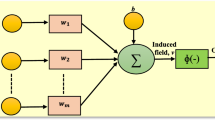Abstract
Neural networks are becoming very popular with data mining practitioners because they have proven through comparison their predictive power with statistical techniques using real data sets. Based on this idea, we will present a method for inducing logical rules from empirical data—Reverse Analysis. When the values of the connections of a neural network resulting from Hebbian learning for the data are given, we hope to know what logical rules are entrenched in it. This method is tested with some real life data sets. In real life data sets, logical rules are assumed to be in conjunctive normal form (CNF) since Horn clauses are inadequate.
Similar content being viewed by others
References
Haykin S (1998) Neural network: a comprehensive foundation. Macmillan, New York
Ehyal K, Michael M (2009) Extracting symbolic knowledge from recurrent neural networks—a fuzzy logic approach. Fuzzy Sets Syst 160(2): 145–161
Mantas CJ, Puche JM, Mantas JM (2006) Extraction of similarity based fuzzy rules from artificial neural networks. Int J Approx Reason 43: 202–221
Kasabov N (2006) Adaptation and interaction in dynamical systems; Modelling and rule discovery through evolving connectionist systems. Appl Soft Comput 6: 307–322
d’Avila Garcez AS, Broda K, Gabbay DM (2002) Neural-symbolic learning systems: foundations and applications. In: Perspectives in neural computing. Springer, Berlin. ISBN:1-85233-512-2
Wan Abdullah WAT et al (1991) Neural network logic. In: Benhar O et al (eds) Neural networks: from biology to high energy physics. ETS Editrice, Pisa, pp 135–142
Wan Abdullah WAT (1992) Logic programming on a neural network. Int J Intell Syst 7: 513–519
Wan Abdullah WAT (1993) The logic of neural networks. Phys Lett 176A: 202–206
Wan Abdullah WAT, Sathasivam S (2005) Logic mining using neural networks. In: Proceedings of the international conference in intelligent system 2005 (ICIS 2005), Kuala Lumpur, Malaysia
Abdullah W, Tajuddin WA, Sathasivam S (2006) Logical rules induction. In: Proceedings of the 2nd IMT-GT regional conference on mathematics, statistics and applications, Penang, Malaysia
Hopfield JJ, Tank DW (1985) Neural computation of decisions in optimization problems. Biol Cyber 52: 141–152
Sathasivam S (2007) Logic mining in neural network. PhD thesis, Malaysia
Geszti T (1990) Physical models of neural networks. World Scientific, New Jersey
Sathasivam S, Abdullah W, Tajuddin WA (2007) Flatness of the energy landscape for Horn ClausesLogic. Matematika 23: 147–156
Sathasivam S, Abdullah W, Tajuddin WA (2008) Logic learning in Hopfield networks. Mod Appl Sci 2: 57–63
Liberatore P (2004) Redundancy in Logic I: propositional formula. Artif Intell 163: 135–142
Raj A (2005) Private communication
Roberto J, Bayardo JR, Agrawal R (1999) Mining the most interesting rules. In: ACM SIGKOD international conference on knowledge discovery and data mining in USA, pp 145–154
Piatetsky-Shapiro G (1991) Discovery, analysis, and presentation of strong rules. Knowledge discovery in databases. AAAI/MIT Press, Cambridge, pp 229–248
Do TD, Hui SC, Fong ACM (2005) Prediction confidence for associative classification. In: Proceedings of the fourth international conference on machine learning and cybernetics, Guangzhou, pp 1993–1998
Verykios VS, Elmagarmid AK, Bertino E, Saygin Y, Dasseni E (2004) Association rule hiding. IEEE Trans Knowl Data Eng 16(4): 434–447
Zaki MJ (2000) Generating non-redundant association rules. In: Proceedings of the sixth ACM SIGKDD international conference on knowledge discovery and data mining, pp 34–43
Lu Y, Lu S, Fotouhi F, Sun Y, Yang Z, Liang LR (2006) PDC: pattern discovery with confidence in DNA sequences. In: Proceedings of advances in computer science and technology, Mexico
Zhang S, Lu J, Zhang C (2004) A fuzzy logic based method to acquire user threshold of minimum support for mining association rules. Int J Inf Sci Inform Comp Sci 164(1–4): 1–16
Xiong H, Tan PN, Kumar V (1993) Mining strong affinity association patterns in data set with skewed support. In: Proceedings of 3rd IEEE international conference on data mining
Author information
Authors and Affiliations
Corresponding author
Additional information
Communicated by R. Neruda.
Rights and permissions
About this article
Cite this article
Sathasivam, S., Wan Abdullah, W.A.T. Logic mining in neural network: reverse analysis method. Computing 91, 119–133 (2011). https://doi.org/10.1007/s00607-010-0117-9
Received:
Accepted:
Published:
Issue Date:
DOI: https://doi.org/10.1007/s00607-010-0117-9




